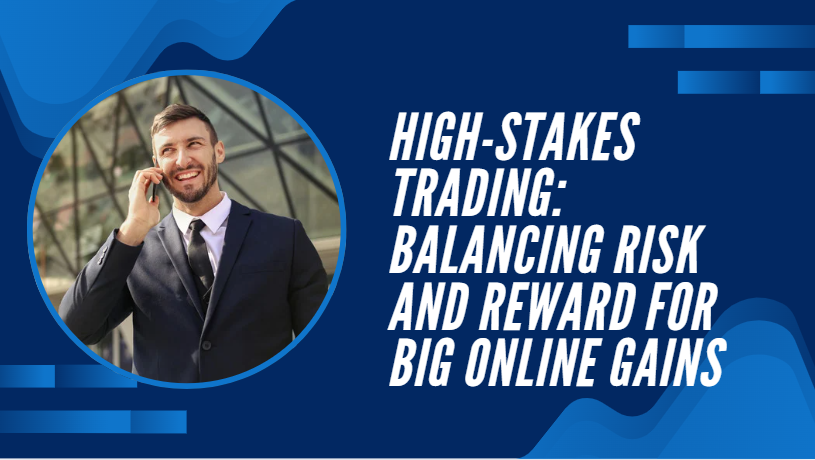High-stakes trading is a path many pursue for its potential to yield substantial profits. However, it’s not just about the thrill of big wins—it requires strategic thinking, discipline, and the ability to handle significant risks. For those interested in trading, whether you’re new or experienced, understanding how to balance risk and reward is crucial for long-term success. Below, we explore how to master high-stakes trading and transform your approach to online gains.
1. The Basics of High-Stakes Trading
High-stakes trading can be defined as trading with significant financial exposure in hopes of earning significant profits. This can be done across various markets such as stocks, cryptocurrencies, forex, and options. The nature of high-stakes trading requires quick decision-making and thorough market analysis to navigate unpredictable shifts. Success in this field depends on not only recognizing opportunities but also managing risks intelligently.
2. Risk Management Strategies
Effective risk management is essential for high-stakes trading. Without it, even the most skilled traders can face substantial losses. Here are strategies to help manage risk:
- Set a Risk-to-Reward Ratio: This ratio is crucial for determining whether a trade is worth the potential risk. A ratio of 1:2, for example, means that for every dollar risked, you aim to make two dollars. This helps ensure your gains can offset losses over time.
- Use Stop-Loss Orders: These are automated orders that limit losses by closing a position when the asset price hits a set level. This minimizes potential damage and ensures you don’t lose more than you’re willing to risk.
- Diversify Your Portfolio: Don’t place all your funds into one trade. Spreading your capital across different assets can reduce the risk of a major loss affecting your entire trading balance.
- Limit Your Exposure: Ensure you’re only risking a small percentage of your total capital per trade. This protects you from large-scale losses that could deplete your trading account.
3. Choosing the Right Market
Different trading markets offer different risks and opportunities. Here’s how to choose the best market for high-stakes trading:
- Stock Market: Popular for its range of opportunities, particularly in growth sectors and IPOs. While stocks can yield high returns, they come with market volatility and require thorough research.
- Forex Market: Known for its high liquidity and 24/5 availability, the forex market can be ideal for high-stakes traders who can handle rapid price changes and global economic factors.
- Cryptocurrency Market: This market is notorious for its extreme volatility. While it can offer enormous profit potential, it also comes with significant risks. Successful traders in this market are often those who stay updated on regulatory changes and market trends.
- Options Trading: Offers the potential for substantial gains but comes with complex strategies. Options can be used for hedging or leveraging, and require a firm grasp of concepts like spreads and volatility.
4. Creating a Winning Strategy
A well-thought-out strategy is your foundation for trading success. Without one, you’re more likely to make impulsive decisions that lead to losses. Here’s how to create an effective trading strategy:
- Conduct Thorough Research: Before entering any trade, understand the asset, its historical performance, and the factors that could influence its price. This helps you make informed decisions rather than relying on gut feelings.
- Use Technical Analysis: This involves analyzing historical price data to identify trends and patterns. Tools like moving averages, RSI, and MACD can help you identify the best entry and exit points.
- Combine Technical and Fundamental Analysis: While technical analysis is great for short-term trading, understanding the underlying fundamentals (such as company earnings reports or economic indicators) provides valuable context.
- Plan Your Entry and Exit Points: Having a clear plan for entering and exiting trades is crucial. This minimizes the chance of impulsive actions and ensures you maintain control over your trading decisions.
5. Maintaining Emotional Control
Trading is as much a mental game as it is a financial one. High-stakes trading can be stressful and even overwhelming at times, so emotional control is key:
- Stick to Your Trading Plan: Having a structured plan that outlines your strategy, entry/exit points, and risk management tactics can help you avoid making impulsive decisions during high-pressure situations.
- Take Breaks: Spending long hours in front of a screen can lead to fatigue, impacting your focus and decision-making. Regular breaks can help you stay sharp and make better trading choices.
- Practice Mindfulness: Techniques such as meditation or deep breathing exercises can keep your stress levels low and help you stay clear-headed during trading hours.
- Accept Losses: Understand that losses are part of trading. Even seasoned traders experience them, but it’s important not to let them dictate your future actions. Avoid the temptation to chase losses by making hasty, high-risk trades.
6. Essential Tools for High-Stakes Trading
To navigate high-stakes trading, you need the right set of tools:
- Trading Platforms: Choose platforms that offer advanced charting capabilities, real-time data, and ease of use. Popular options include Meta Trader 4/5, Trading View, and Think or Swim.
- Economic Calendars: Keep an eye on upcoming events such as GDP releases, job reports, and central bank meetings. These can affect market movement and give you an edge in predicting price action.
- News Outlets: Stay informed with up-to-the-minute news from sources like Bloomberg, CNBC, and Reuters. Market-moving events are often tied to global economic news.
- Trading Journal: Maintaining a journal helps you track your trades, learn from mistakes, and identify what strategies work best for you.
7. The Journey to Long-Term Trading Success
High-stakes trading is not a get-rich-quick scheme—it requires time, practice, and learning from both wins and losses. The most successful traders continuously refine their strategies, stay informed, and adapt to changing market conditions. Keep in mind that building long-term profitability in trading is a marathon, not a sprint.
